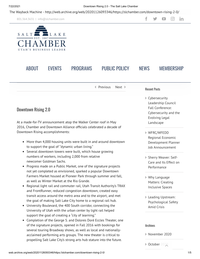CCC served as a catalyst for other downtown SLC investments.
- Type
- Website
- Source
- Marisa Bomis
- Hearsay
- 2nd Hand
- Reference
Marisa Bomis, “Downtown Rising 2.0,” Salt Lake Chamber, April 6, 2017, accessed July 1, 2021
- Scribe/Publisher
- Salt Lake Chamber
- People
- Salt Lake Chamber, Marisa Bomis, Downtown Alliance, Lane Beattie, Jason Mathis
- Audience
- Reading Public
- Transcription
Downtown Rising 2.0
At a made-for-TV announcement atop the Walker Center roof in May 2016, Chamber and Downtown Alliance officials celebrated a decade of Downtown Rising accomplishments:
• More than 4,000 housing units were built in and around downtown to support the goal of “dynamic urban living.”
• Several downtown towers were built, which house growing numbers of workers, including 2,000 from relative newcomer Goldman Sachs.
• Progress made on a Public Market, one of the signature projects not yet completed as envisioned, sparked a popular Downtown Farmers Market housed at Pioneer Park through summer and fall, as well as Winter Market at the Rio Grande.
• Regional light rail and commuter rail, Utah Transit Authority’s TRAX and FrontRunner, reduced congestion downtown, created easy transit access around the metro area and to the airport, and met the goal of making Salt Lake City home to a regional rail hub.
• University Boulevard, the 400 South corridor, connecting the University of Utah with the urban center by light rail helped support the goal of creating a “city of learning.”
• Completion of the George S. and Dolores Doré Eccles Theater, one of the signature projects, opened in Fall 2016 with bookings for several touring Broadway shows, as well as local and nationally-acclaimed performing arts groups. The new theater is critical to propelling Salt Lake City’s strong arts hub stature into the future.
Jason Mathis, executive director of the Downtown Alliance, gives credit to Beattie for creating the vision that became Downtown Rising.
“Lane Beattie’s idea was ‘How can we capitalize on the The Church of Jesus Christ of Latter-day Saints’ investment that we know will be made in the urban center? How can we broaden out this into a vision that involves the whole community? How can we leverage what will happen in those two blocks to create something even more dynamic and valuable for all of downtown?’” Mathis said.
Funding for the projects totaled more in a shorter period than any previous investment in the city’s history. The City Creek Center project, coupled with the Downtown Rising plan, sparked downtown investment and revitalization. With the The Church of Jesus Christ of Latter-day Saints’ generous initial investment of about $1.5 billion, Beattie said that this commitment served as a catalyst to attract another $3.5 billion in further investments to downtown in construction and infrastructure improvements.
“It was an investment that drew a line in the sand that said, ‘This is what we are going to do.’ All of a sudden, you saw a lot of other people get involved, start investing and it got exciting,” Beattie said.
At the May 2016 event marking Downtown Rising’s first decade, Chamber, business and community leaders announced a process to create a framework dubbed Downtown Rising 2.0.
The Downtown Alliance identified ten priorities and ten signature projects to build on earlier accomplishments. The Downtown Alliance said it would engage the community through social media outreach, public surveys and public open houses to determine priorities. This public input was used to solidify recommendations made by the Downtown Rising steering committee, made up of property owners, community leaders and public officials, and was unveiled in 2017.
“Downtown Rising needs to be part of any history of the Chamber because it has done extremely well,” Beattie said. “During the years it was implemented, everyone was talking about Downtown Rising, and we had funds that were donated by business leaders that gave us the ability to help do the advertising, follow up with people, and to get input. It became an absolutely incredible plan that was adopted by the city.”
Looking forward, Downtown Rising has become a living, breathing aspirational plan with stakeholders that range from business interests to public officials, and ecclesiastical leaders to community groups. The collaboration over the past decade-plus grew downtown’s skyline, strengthened the city’s economy and flourished an urban renaissance continues to rise.
- Citations in Mormonr Qnas
The B. H. Roberts Foundation is not owned by, operated by, or affiliated with the Church of Jesus Christ of Latter-day Saints.

